Pittore e fotografo di formazione, filmmaker dal 2014, Brandon Wilson (1982) è una delle voci più interessanti e al contempo sconosciute del panorama sperimentale americano contemporaneo. Accostabile per molti versi all’inglese Scott Barley, il cinema di Wilson è dotato di un magnetismo ipnotico e umbratile, dirompente nell’utilizzo tecnico del mezzo e lirico nel sondare paesaggi e ambienti tanto organici quanto incorporei.
A questo link è possibile vedere tutti i film di Brandon Wilson discussi in questo articolo:
D.P.
Ciò che mi colpisce di più del tuo lavoro è il montaggio: un fiume in piena che fonde tra loro le immagini invece di giustapporle l’una accanto all’altra. Il cinema, sin dalla sua nascita, è infestato da fantasmi ma vedendo i tuoi film l’impressione che si ha è un’altra e cioè che il tuo stesso cinema si comporti e possa essere definito come tale. In particolare mi riferisco a Ghost Is Hungry (2020) (il titolo è abbastanza esplicito, la mdp divora le immagini che riprende) nel quale questo aspetto emerge prepotentemente e, ripeto, soprattutto grazie alla natura del montaggio (tanto video che audio). Qual è dunque il tuo rapporto con il fantasmatico nel cinema?
B.W.
Non so quale mix di input culturali abbia formato la mia nozione sui fantasmi, ma per me l’idea di un fantasma rappresenta un’esistenza che è radicata nell’insoddisfazione e nella stagnazione. È una mente che permane in un luogo al quale non appartiene più perché non può o non vuole andare avanti. C’è anche una suggestione, o forse più una domanda, di impotenza. Una lotta alla ricerca di un agente rappresentativo, per trovarne poco o niente.
Poi c’è l’idea di un regno soprannaturale. Un luogo dove ci sono ancora le regole dell’esistenza ma sono estranee e sconosciute. Questa situazione si presta bene alla realizzazione di un film. Ad esempio: posso giocare con l’idea di una consapevolezza non incarnata catturando e modificando le immagini in un modo che non trasmetta un unico punto di vista. Ho girato alcune riprese per Ghost is Hungry usando un prisma di vetro fissato all’obiettivo. L’immagine risultante è fratturata ma fluida nel suo movimento. L’ho quindi stratificato con una serie di fotografie fisse altamente dettagliate di alberi e altre strutture boschive che avevo organizzato in una sequenza intermittente a mo’ di staccato. Come sarebbe non essere vincolati a un corpo fisico? Non lo so, ma posso immaginare e condividere queste impressioni facendo un film. Sono attratto da ciò che non riesco a capire e non posso sapere. Voglio celebrarlo.
Il mio interesse per i fantasmi è iniziato con un’esperienza che ho avuto diversi anni fa. Ero sdraiato a letto la notte, le luci erano spente e stavo guardando dall’altra parte della camera quando una luce blu pallida apparve sopra il comò. Era piccola e sfocata, delle dimensioni di un pugno chiuso. Scomparve e riapparve tre o quattro volte. Probabilmente avrei dubitato dell’esperienza ma anche la mia compagna era lì e l’ha vista. Ho pensato che potesse essere il bagliore di un laptop in standby anche se non sembrava proprio così. Non c’erano computer o altri dispositivi elettronici nella stanza. Non ho spiegazioni. Dopo questa esperienza ho percepito la foresta in modo diverso. Il paesaggio sembrava carico di presenza.
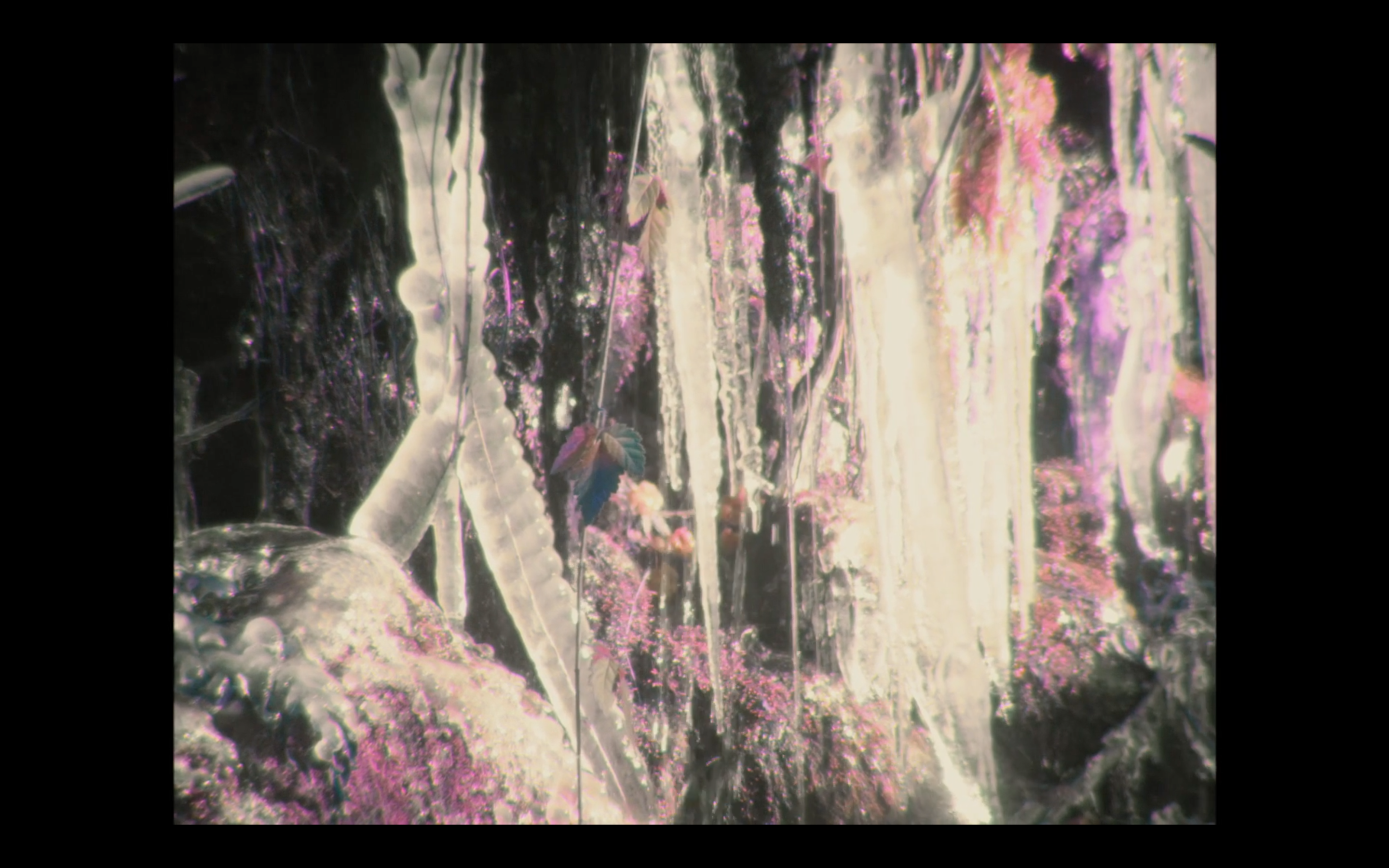
D.P.
Seijun Suzuki diceva: “Why make a movie about something one understands completely? I make movies about things I do not understand, but wish to.” Quando parli di un regno soprannaturale la mia mente non può che andare verso Home in the Woods (2020), l’unico lungometraggio da te realizzato finora, nel quale emerge appieno questa tua percezione della foresta come luogo colmo di presenza dominato da regole aliene e sconosciute. Una cascata si ripete in un loop infinito, la vegetazione si colora di toni marziani e purpurei e i microorganismi che abitano quegli spazi diventano i personaggi della tua esplorazione (non a caso utilizzi un cane come medium affinché avvenga questa connessione). Anche il suono, spesso amplificato ai limiti del caricaturale, contribuisce a distorcere o meglio, svelare, gli strati e le pieghe più nascoste di ciò che filmi. È importante infatti sottolineare come tu ti occupi anche del sound design dei tuoi film. In tutto ciò a rivelarsi come soggetto protagonista della tua opera è il paesaggio. La pittura di paesaggio iniziò a dominare l’arte americana all’inizio del 19o secolo e la storia dell’evoluzione di questo rapporto, come ci ha insegnato il western del resto, è sempre stata caratterizzata da una sublime violenza. Frederick Jackson Turner con The Significance of the Frontier in American History parla di un modello evoluzionistico secondo il quale la formazione dell’identità americana sia stata definita da quanto i coloni europei fossero in grado di domare l’ambiente selvaggio che incontravano nel loro processo di conquista. “Piú si va verso ovest, più si è americani”. A me sembra che tu vada però in tutt’altra direzione. Il tuo è un tentativo di potenziare e liberare quei luoghi dall’impianto e dalle sovrastrutture che gli uomini hanno su di essi calato e per far ciò ti servi del cinema.
B.W.
Le mie intenzioni durante la realizzazione di Home in the Woods erano, come hai suggerito tu, totalmente contrarie agli atteggiamenti di conquista. Aspiravo a essere un intermediario attraverso il quale il paesaggio potesse parlare. Sapevo fin dall’inizio che la conoscenza scientifica e tassonomica non sarebbe stata d’aiuto. Ovviamente quest’ultima è preziosa e importante (non sto discutendo diversamente), ma in questo caso non era lo strumento adatto, poiché l’attuale cultura globale è profondamente parziale e condizionata a considerare la conoscenza scientifica come la più autorevole modalità di comprensione. Non volevo che questo film avesse nulla a che fare con i modelli riduzionisti che gli esseri umani hanno imposto sul mondo. Ripensandoci vorrei aver tralasciato i titoli dei capitoli per consentire all’esperienza di essere il più libera possibile.
Trovare nuovi modi di vedere è diventato fondamentale per il progetto. Avevo bisogno di trovare un modo per superare la mia desensibilizzazione alle cose comunemente osservate, cosa che immagino tutti proviamo in una certa misura. Ho visto innumerevoli piante. Volevo trovare un modo per apprezzare ancora la bellezza di una foglia. Ho escogitato diverse tecniche per alterare l’aspetto e la percezione delle immagini. Il sound design ha perpetrato questo obiettivo. Ho cercato di attirare un diverso livello di attenzione sulle cose, a volte con umorismo. Penso che la foresta abbia approvato. Parlavo spesso con il paesaggio quando uscivo per filmare, di solito in silenzio, a volte ad alta voce, chiedendo il permesso, chiedendo che si rivelasse, spiegando le mie intenzioni.
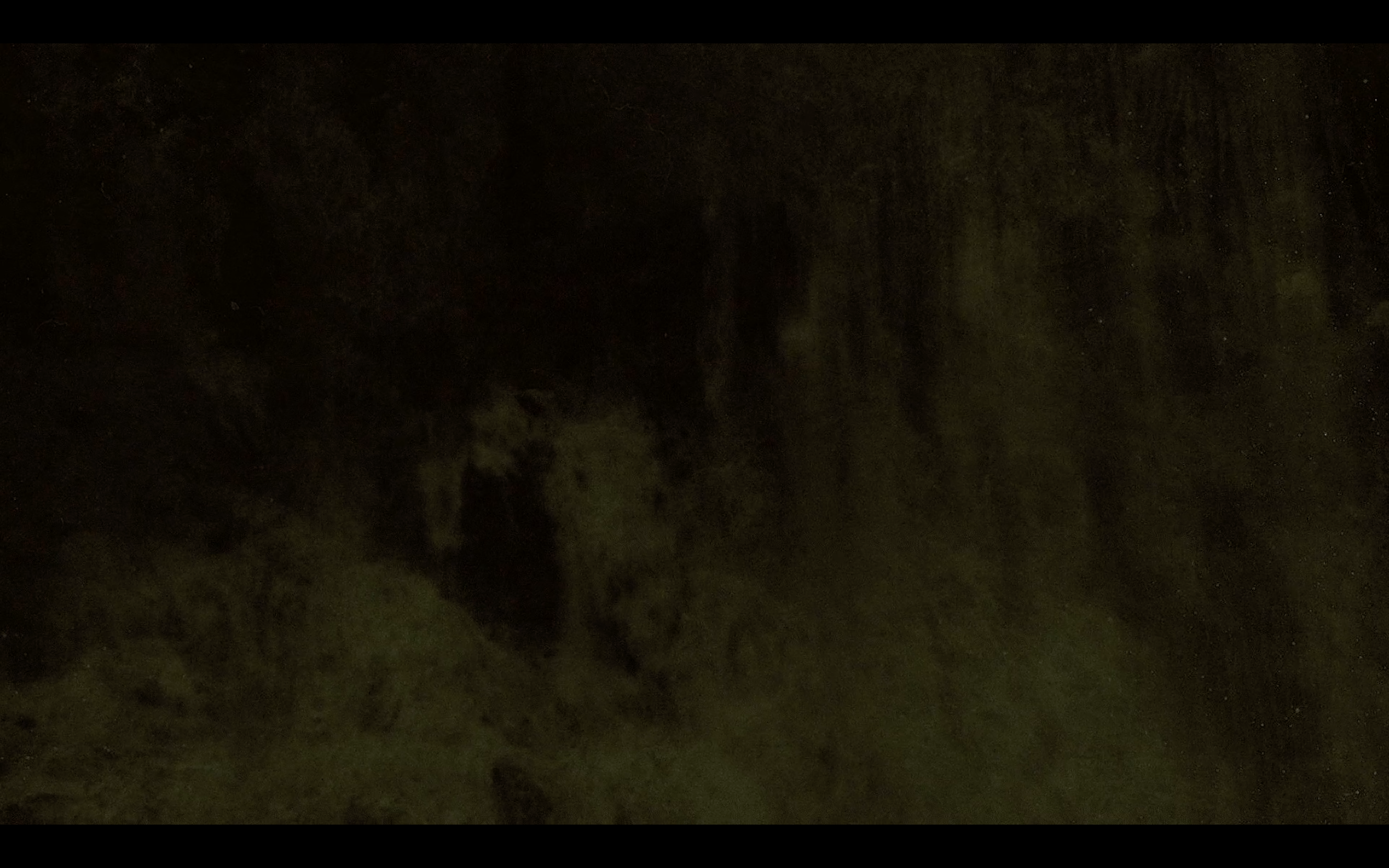
D.P.
È anche vero però che la fiducia dell’uomo verso la credibilità scientifica negli ultimi anni si è incrinata sempre di più e la risposta del mondo alla pandemia ne è stato un chiaro esempio. Io considero il cinema al pari di uno strumento scientifico capace di sondare sfere della conoscenza altrimenti inintelligibili e irraggiungibili dal linguaggio razionale. Basti pensare a Muybridge e ai suoi studi sulla locomozione animale. È grazie a Sallie Gardner at a Gallop che si scoprì come il cavallo sollevi simultaneamente i suoi quattro zoccoli dal terreno solo quando sono raccolti al di sotto del corpo dell’animale. Una connessione con l’ambiente così forte come quella che descrivi deve derivare senz’altro da un tuo personale legame autobiografico con quei luoghi. Nella bio del tuo sito web dici di te: “living next to trees and bugs in nw Oregon”. In una passata discussione inoltre mi accennavi al fatto che tu fossi cresciuto nei deserti del Texas. L’entropia dei deserti, lenta ma inarrestabile, è un fenomeno che favorisce le possibilità espressive del cinema. Mi spiego meglio: in un luogo nel quale la civilizzazione non sia in grado di attecchire poiché costantemente messa alla prova dalla potenza della natura, i gradi di separazione tra passato, presente e futuro si confondono quasi fino a scambiarsi l’uno con l’altro. Il cinema ha nel tempo uno dei suoi caratteri eminenti e questa invalidazione temporale non può che presentarsi come un’opportunità per un filmmaker. La tua relazione con il deserto ha contribuito alla tua formazione personale e artistica e, se sì, come si è evoluta in seguito?
B.W.
Ho ricevuto un’impressione diversa dal deserto. Gli strati esposti di roccia antica mi hanno rivelato la vastità del tempo in cui esisto e come tutte le condizioni, anche quelle che sembrano statiche, alla fine cambieranno. Quelli che oggi sono i deserti del Nord America erano un tempo un mare poco profondo che divideva a metà l’attuale continente. Si ritiene che sia stato così per circa 60 milioni di anni fino a quando l’attività tettonica non ha spinto la terra verso l’alto e il mare si è gradualmente ritirato. Ho visto resti pietrificati di alberi che un tempo crescevano lungo la riva di questo mare dove ora non cresce quasi niente — certamente niente di così grande. Alla fine ho iniziato a vedere la terra come solo un altro corpo temporaneo. Tutte le cose sembravano parte di un’unica, instabile narrativa. Questa idea di fluidità universale e la sensazione di esserne parte (non importa quanto piccola o breve) rimane importante per me. È una prospettiva in cui gli esseri umani non sono centrali. Raramente includo persone nel mio lavoro e quando lo faccio cerco di metterle in relazione con il non umano.
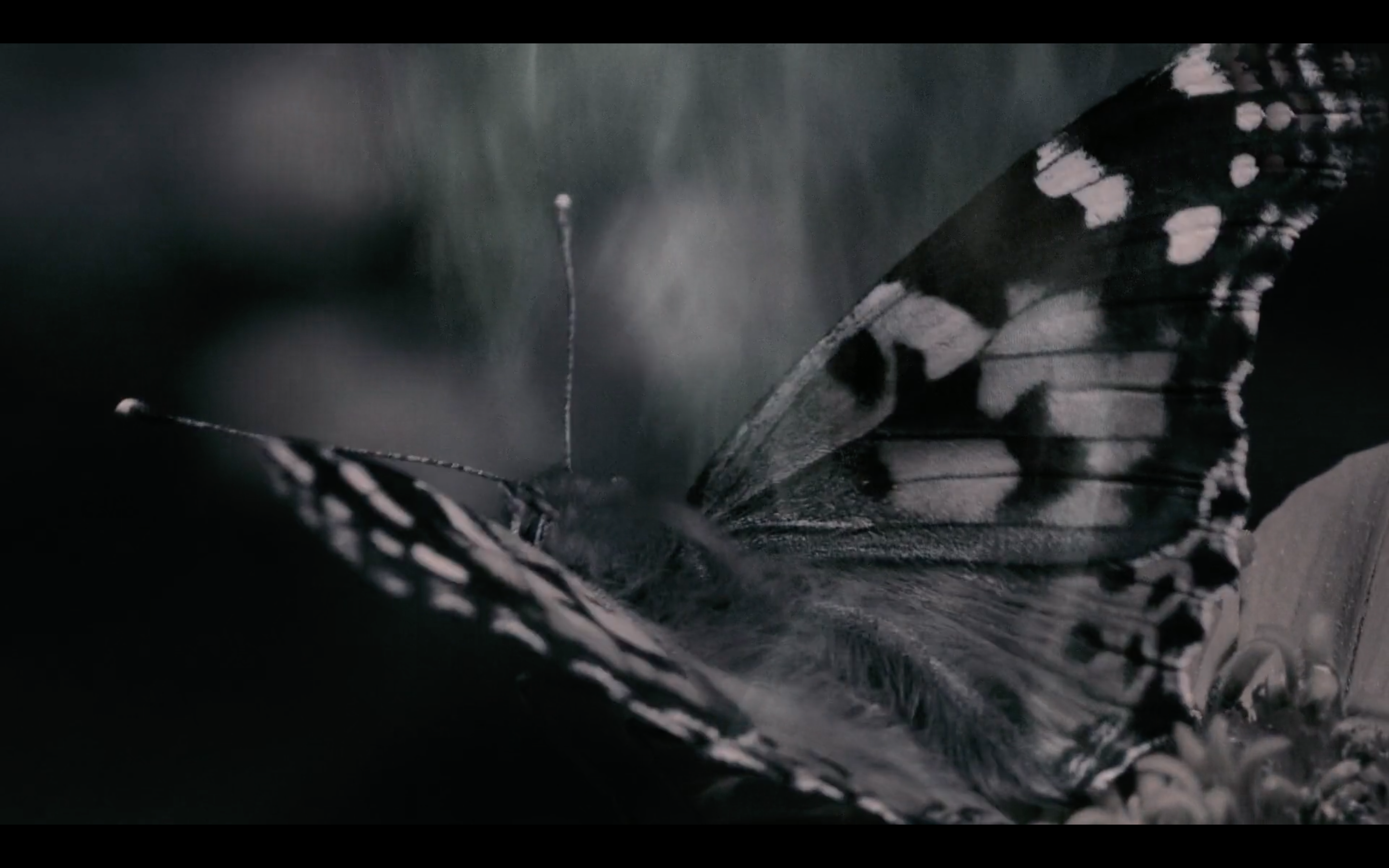
D.P.
Credo Treading Night Ocean (2020) riassuma esattamente ciò. La stratificazione e la densità visiva che raggiungi in questo lavoro, seppur accomunate da quel flusso di cui parlavamo all’inizio, si discosta parecchio dal resto della tua opera. L’idea che esprimi di una fluidità universale e di un corpo temporaneo, ma anche temporale aggiungerei, si manifesta nel corpo mellifluo e pittorico del bosco ritratto. Quest’ultimo appare nientemeno che un essere vivente e la sua immagine si propaga con lievi emersioni dall’oscurità che pervade lo schermo. Mi incuriosiva particolarmente sapere cosa ti abbia portato all’adozione e alla differenziazione del processo creativo con cui hai creato Treading Night Ocean, sempre che tu veda una differenza d’approccio.
B.W.
Mi sento come se fossi andato in una nuova direzione con Treading Night Ocean. Ho lavorato sia con immagini fisse che in movimento. Le immagini fisse mi permettono di scolpire i paesaggi in qualcosa di surreale e oscuro. Dissolvendo le une nelle altre e combinandole con filmati d’acqua a ralenti ho creato un contesto in continuo mutamento che rende impossibile aggrapparsi a qualsiasi interpretazione per molto tempo. Volevo questa instabilità. Con tutto ciò stavo cercando di far emergere uno stato mentale riconoscibile ma senza nome. È interessante per me che non abbiamo nomi per molti degli stati che sperimentiamo ed è facile essere ciechi di fronte a qualcosa per cui non ho un nome o un concetto.
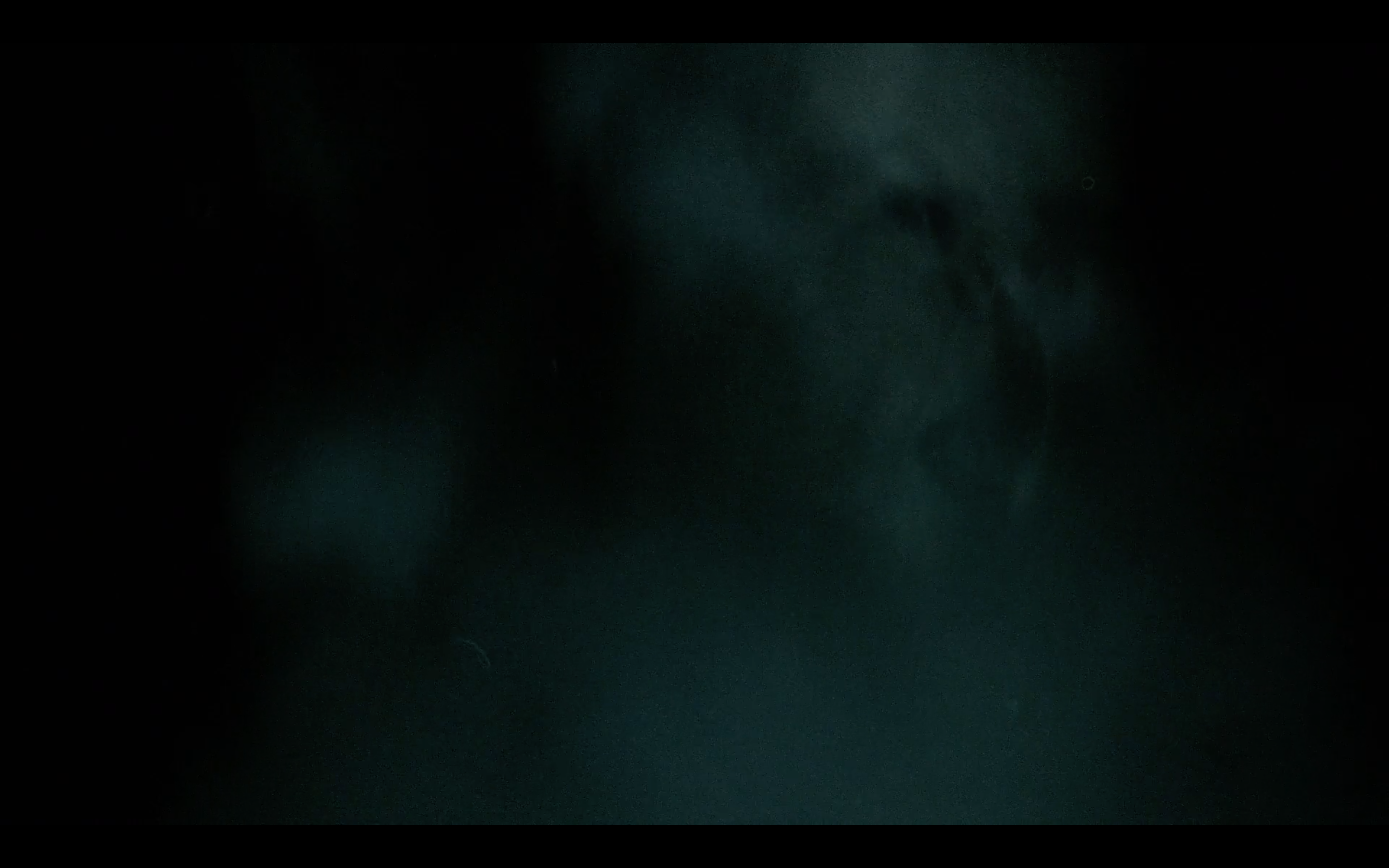
D.P.
Dato che abbiamo iniziato con Ghost is Hungry vorrei fare un’ultima domanda con un altro film “fantasma”, quello con cui ti ho conosciuto durante lo Slow Film Festival 2020 dove il tuo film, Ghost Nursery (2019), si trovava nella sezione principale. All’inizio del film ti accorgi lentamente che quello che stai guardando è un corso d’acqua che sembra quasi vivo. È anche possibile vedere dei volti che si formano e si disintegrano immediatamente nei riflessi prodotti dall’acqua. Come sei riuscito a ottenere un effetto del genere? Mi diresti anche quale set di fotocamere e obiettivi hai usato per girare i tuoi film?
B.W.
Ghost Nursery è stato il mio primo film fantasmatico. È molto personale per me. I volti che vedi nell’acqua sono fotografie di me stesso scattate dai miei genitori quando avevo solo poche settimane di vita. A causa di eventi del mio passato appena precedente a quando stavo lavorando a questo film, ho sentito il bisogno di distruggere simbolicamente il mio io pregresso. Non credo sia necessario saperlo per vedere il film, ma questo è stato il mio processo mentale.
Il processo tecnico per i volti è stato piuttosto semplice. Ho manipolato le immagini usando Photoshop. Ho fatto del mio meglio per distorcere il mio viso in qualcosa di grottesco e irriconoscibile dal viso di un neonato. Ho quindi animato i volti manipolati in AfterEffects utilizzando degli strumenti base per ottenere un movimento increspato. Sono stati quindi composti con i filmati della cascata a bassissima opacità.
Ottenere il filmato della cascata non è stato così semplice. Ho dovuto girarlo in inverno perché è in quel momento che il flusso è maggiore, quindi era una fredda mattina di febbraio quando ero lì. Ho dovuto arrampicarmi per scendere vicino alla base della cascata e camminare attraverso gli spruzzi con la mia attrezzatura. Non ha funzionato la prima volta, quindi ho dovuto tornare indietro e riprovare, e ancora non ha funzionato, quindi sono tornato una terza volta. Ho usato un dispositivo che ruotava la fotocamera a una velocità precisa in modo da poter invertire il filmato e unirlo senza intoppi. Il risultato finale non è ancora perfetto ma non ero disposto a tornare indietro una quarta volta. Dopo la terza volta, quando sono risalito e mi sono allontanato dal rumore, ho iniziato a dissociarmi e ho deciso che non sarei più tornato laggiù.
Per quanto riguarda l’attrezzatura, utilizzo una fotocamera Panasonic GH4. Ho alcune lenti. Una di queste è un bell’obiettivo digitale che produce immagini nitide. Questa è la lente che ho usato per Ghost Nursery. Il resto sono lenti economiche. Una che tendo a usare spesso è un obiettivo Olympus di una fotocamera a pellicola SLR degli anni ’70. Ha un aspetto particolare che adoro. L’equipaggiamento è allo stesso tempo importante e non importante per me. Voglio sapere come usare bene i miei strumenti, ma non voglio farne un feticcio, che siano costosi o economici.
Questa conversazione, tenutasi tra novembre 2021 e febbraio 2022, é dedicata alla memoria di Chase (2005 – 2021), il cane di Brandon Wilson presente in Home in the Woods.
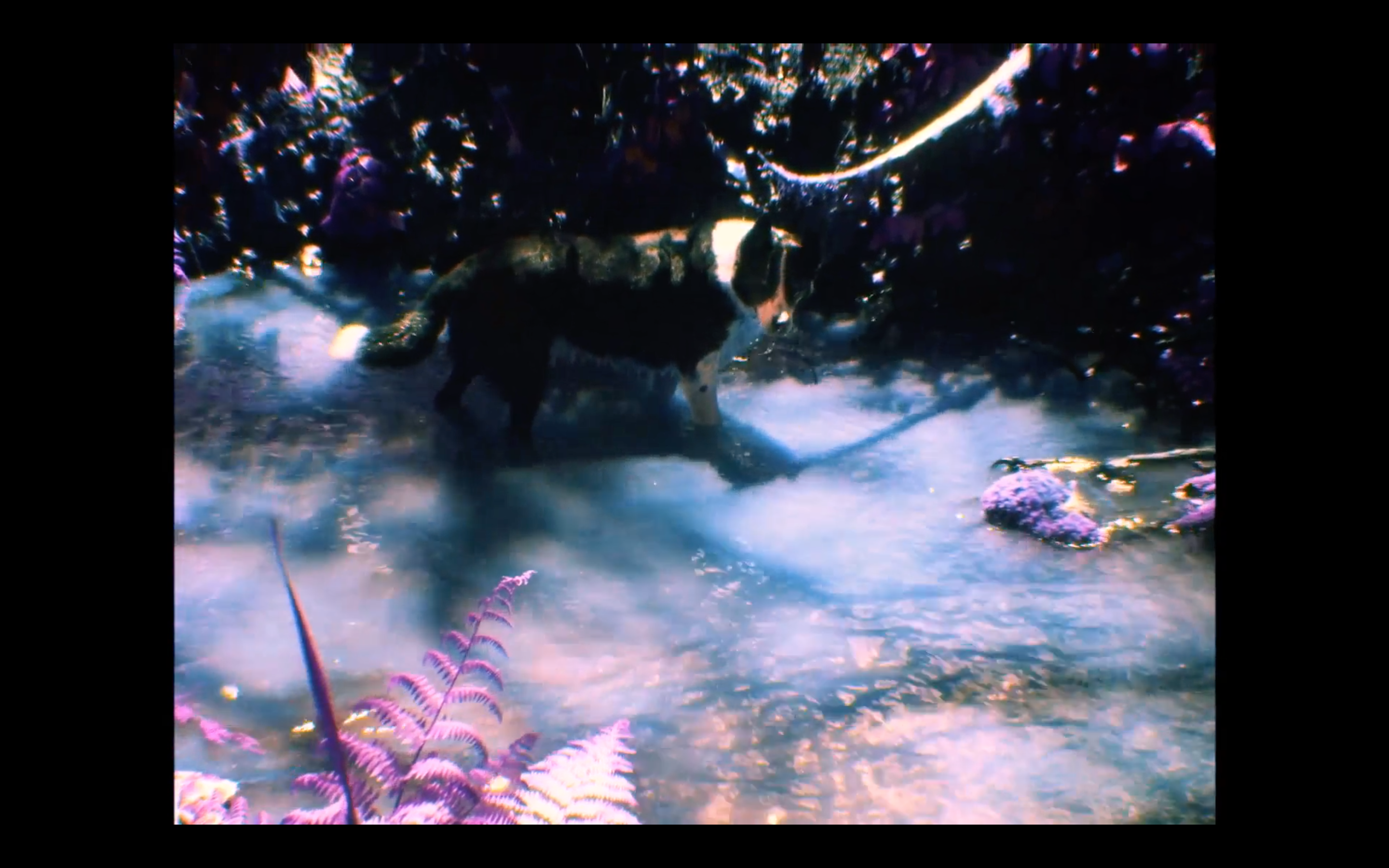
ENG
D.P.
The one thing that strikes me the most in your work is the editing which it feels like a streaming river that melts the images together instead of juxtaposing them one beside the other. Cinema, from its birth, is haunted by ghosts but by watching your films the impression one has is another: that your own cinema behaves and can be defined as such. I’m referring in particular to Ghost is Hungry (2020) (the title itself is self- explanatory, the camera devours the images it shoots) in which this feature emerges overwhelmingly, I’ll repeat, mainly due to the editing’s nature (both video and sound). What is, then, your relationship with the phantasmatic in cinema?
B.W.
I don’t know what mix of cultural inputs formed my notion of ghosts, but for me the idea of a ghost represents an existence that’s rooted in dissatisfaction and stagnation. It’s a mind that remains where it no longer belongs because it can’t or won’t move on. There is also a suggestion, or maybe more of a question, of powerlessness. A struggle to find agency but finding little to none.
Then there is the idea of a supernatural realm. A place where there are still rules of existence but they are alien and unknown. This situation lends itself well to making films. As one example: I can play with the idea of an unembodied awareness by shooting and editing images in a way that doesn’t convey a singular viewpoint. I shot some footage for Ghost is Hungry using a glass prism held to the lens. The resulting image is fractured but fluid in its motion. I then layered this with a series of highly detailed still photographs of trees and other forest textures that I had arranged in a staccato, flashing sequence. What would it be like, not being bound to a physical body? I don’t know, but I can imagine and share these impressions by making a film. I’m attracted to what I can’t understand and can’t know. I want to celebrate it.
My interest in ghosts began with an experience I had several years ago. I was lying in bed at night, the lights were out and I was looking across the bedroom when a pale blue light appeared above the dresser. It was soft-edged and small, the size of a clenched fist. It disappeared and reappeared three or four times. I probably would have doubted the experience but my partner was there and saw it too. I thought it might be the glow of a sleeping laptop even though it didn’t really look like it. There was no laptop or any other electronics in the room. I have no explanation. After this experience I perceived the forest differently. The landscape felt loaded with presence.
D.P.
Seijun Suzuki said: “Why make a movie about something one understands completely? I make movies about things I do not understand, but wish to.”
When you speak of a supernatural realm my mind goes straight to Home in the Woods (2020), the only feature length film you made up until now. There it emerges fully your perception of the forest as a place filled with presence, ruled by alien and unknown laws. A waterfall keeps going on an infinite loop, the vegetation is colored by martian, purplish hues and the microorganisms that inhabit those sites become the characters of your exploration (not by chance you make use of a dog as a medium so that this connection may take place). Also the sound, often amplified to the point of being caricatural, contributes in distorting or even better, unveil, the most hidden layers and folds of what you film. It is important indeed to emphasize how you take care of your film’s sound design as well. In all of this the landscape is what reveals itself to be the main subject of your work.
Landscape painting started dominating American art in the early 19th century and the history of the evolution of this relationship, as western taught us after all, has always been marked by a sublime violence. Frederick Jackson Turner with his The Significance of the Frontier in American History discusses of an evolutionary model by which the formation of the American identity was determined by how much the European settlers were capable of taming the wild environment encountered through their conquesting process. “The more you go West, the more American you become”.
It seems to me you’re going in quite another direction. Yours is an attempt to strengthen and liberate those places from the framework and the superstructures men have assigned them, and cinema serves you in your purpose.
B.W.
My intentions while making Home in the Woods were, like you suggested, totally opposed to attitudes of conquest. I aspired to be an intermediary through which the landscape could speak. I knew from the beginning that scientific, taxonomic knowledge was not going to be helpful. It’s of course valuable and important (I’m not arguing otherwise), but in this case it wasn’t the right tool, because the current global culture is highly biased and conditioned to consider scientific knowledge as the most valuable mode of understanding. I didn’t want this film to have anything to do with reductionary models that humans have imposed on the world. I now wish that I would have left out the chapter titles to allow the experience to be as free as possible.
Finding new ways of seeing became crucial to the project. I needed to find a way to overcome my desensitization to commonly observed things, which I imagine we all have to some extent. I’ve seen countless plants. I wanted to find a way to appreciate the beauty of a leaf again. I came up with different techniques to alter the appearance and perception of the images. The sound design furthered this goal. I tried to draw a different level of attention to things, sometimes with humor. I think the forest approved. I would often talk to the landscape when I would go out to film, usually silently, sometimes out loud, asking for permission, asking for it to reveal itself, explaining my intentions.
D.P.
It is also true that men’s trust towards scientific credibility in the past years has increasingly degenerated, and the world’s answer to the pandemic is a clear example of that. I consider Cinema to be at the same level of a scientific tool, capable of probing spheres of the knowledge otherwise unintelligible and unattainable by the sole rational language. It suffices to think of Muybridge and his studies on animal locomotion. It is thanks to Sallie Gardner at a Gallop that it was discovered of how the horse raised simultaneously all four hooves from the ground only when they were collected under the animal’s body. So strong a connection with the environment as the one you describe must derive surely from a personal and autobiographical bond with those places. On your website’s bio you write of yourself: “living next to trees and bugs in nw Oregon”. In a previous discussion you also mentioned that you were raised in the deserts of Texas. The entropy of the desert, steady yet inexorable, is a phenomenon that fosters Cinema’s expressive possibilities. I’ll elaborate: in a place where civilization is incapable of taking root because constantly challenged by the force of Nature, the distinction between past, present and future gets unclear almost to the point of being unable to differentiate. Cinema holds in Time one of its distinguishing features and this temporal invalidation can only present itself as an opportunity for a filmmaker. Has your relationship with the desert contributed to your personal and artistic development? If yes, how did it mature afterwards?
B.W.
I’ve been given a different impression by the desert. The exposed layers of ancient rock revealed to me the vastness of time that I exist within and how all conditions, even ones that appear static, will eventually change. What are now the deserts of North America were once a shallow sea that split the current continent in half. It’s believed to have been that way for about 60 million years until tectonic activity pushed the land upwards and the sea gradually receded. I’ve seen petrified remains of trees that once grew along the shore of this sea where almost nothing grows now—certainly nothing as large. Eventually I started to see the earth as just another temporary body. All things felt like part of a single, unstable narrative. This idea of universal fluidity and the feeling that I am a part of it (no matter how small or brief) has remained important to me. It’s a perspective in which humans are not central. I rarely include people in my work and when I do I try to place them in relation to the non-human.
D.P.
I think Treading Night Ocean (2020) summarises exactly that. The visual stratification and density that you achieved in this work, although united by the same flow of which we discussed at the beginning, differ greatly from your other films. The idea you express of a universal fluidity, of a temporary body (I would also say temporal) manifests itself in the pictorial and mellifluous corpus of the portrayed woods. This appears no less than a living being and its image propels itself with subtle emersions from obscurity, pervading the screen. I was particularly curious about what brought you to adopting and differentiating a new creative process, through which you made Treading Night Ocean. This is of course if you think there is a distinction in approaches.
B.W.
I do feel like I went in a new direction with Treading Night Ocean. I worked with both still and moving images. Stills let me sculpt landscapes into something surreal and obscure. Fading them into each other and combining them with slowed down footage of water created a situation of continuously shifting context that makes it impossible to cling to any interpretation for very long. I wanted this instability. With all of this I was trying to tease out a recognizable but nameless mental state. It’s interesting to me that we don’t have names for many of the states we experience and it’s easy to be blind to something I don’t have a name for, or a concept of.
D.P.
Since we’ve started with Ghost is Hungry I’d like to make one last question with another “ghostly” film, the one with which I’ve known you during the Slow Film Festival 2020 where your film, Ghost Nursery (2019), was in the main section. At the beginning of the film you slowly realize that what you are watching is a stream of water which seems almost alive. It is even possible to see faces forming and immediately falling apart in the reflections produced by the water. How did you manage to achieve such an effect? Would you also tell me which camera and lens set you used to shoot your films?
B.W.
Ghost Nursery was my first ghost film. It’s a very personal one for me. The faces that you see in the water are photographs of myself taken by my parents when I was just a few weeks old. Due to events in my life just previous to when I was working on this film, I felt the need to symbolically destroy my past self. I don’t think it’s necessary to know this in order to watch the film, but that was my thought process.
The technical process for the faces was pretty simple. I manipulated the images using Photoshop. I did my best to distort my face into something grotesque and unrecognizable as the face of a newborn baby. I then animated the manipulated faces in AfterEffects using basic tools to achieve a rippling movement. They were then composited with the waterfall footage at very low opacity.
Getting the footage of the waterfall was not as simple. I had to shoot it in winter because that’s when the flow is big, so it was a cold February morning when I was down there. I had to climb down the rocks next to the waterfall and walk through the spray with my equipment. It didn’t work the first time so I had to go back and try again. And it still didn’t work, so I went back a third time. I used a device that rotated the camera at a precise speed so that I could reverse the footage and splice it smoothly. The end result still isn’t perfect but I wasn’t willing to go back a fourth time. After the third time, as I climbed back up and walked away from the noise I started to dissociate and I decided I was done with going down there.
As for gear, I use a Panasonic GH4 camera. I have a few lenses. One of them is a nice digital lens that produces sharp images. That’s the lens I used for Ghost Nursery. The rest are cheap lenses. One I tend to use often is an Olympus lens from a 1970’s SLR film camera. It has a certain look that I love. Gear is both important and not important to me. I want to know how to use my tools well, but I don’t want to fetishize them–whether it’s for being expensive or cheap.
This conversation, held between November 2021 and February 2022, is dedicated to the memory of Chase (2005 – 2021), Brandon Wilson’s dog appearing in Home in the Woods.